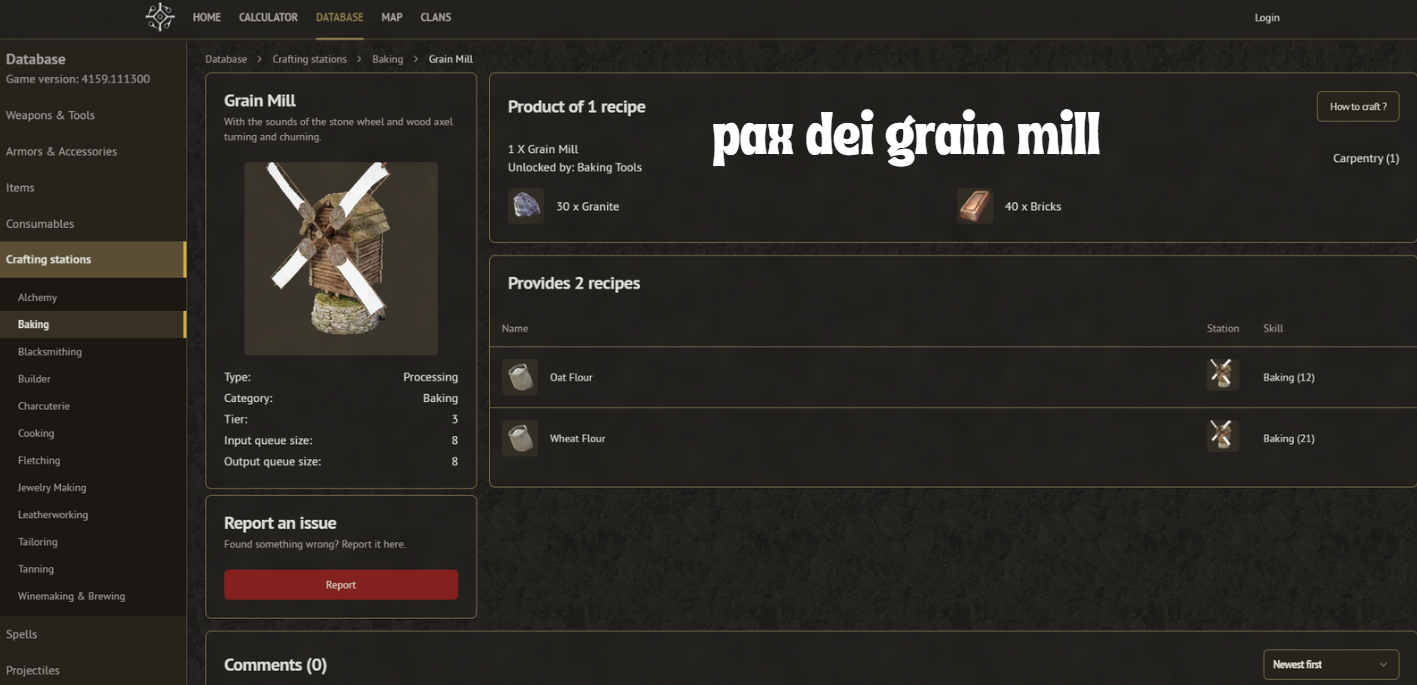Pax Dei Grain Mill: A Comprehensive Guide to Traditional Grain Milling for the Modern Age
Grain milling has a rich historical legacy, stretching back to ancient times when stones were used to crush grains into flour. Today, while modern machinery has revolutionized how flour is made, the traditional stone grain mill still holds a unique place in culinary culture.
The Pax Dei Grain Mill, a third-tier grain processor, embodies this balance of old-world charm and modern practicality. With its distinctive stone wheel and wood axle, this grain mill evokes the rhythmic churning sounds of ancient craftsmanship.
In this article, we’ll take an in-depth look at the Pax Dei Grain Mill, its features, applications, benefits, and how it compares to modern grain mills. We will also discuss its significance in the USA market and why it is increasingly popular among people looking to embrace a more hands-on, traditional approach to baking.

ALSO READ: Exploring // rivenisnet: The Ultimate Guide
Introduction to the Pax Dei Grain Mill
The Pax Dei Grain Mill is more than just a tool for grinding grains; it is an homage to the traditional methods of milling. While it is categorized as a Tier 3 grain processor, it offers a unique combination of functionality and heritage, allowing bakers and home cooks to enjoy the benefits of freshly milled flour with the comforting sounds of a stone wheel and wooden axle at work. This mill is perfect for anyone looking to reconnect with the essence of baking, where the process is just as important as the final product.
For many, the Pax Dei Grain Mill represents a return to basics in a world dominated by automation. By embracing manual processes like grain milling, people can experience the full sensory delight of bread making—from the grain’s aroma as it’s ground to the texture of flour as it’s kneaded into dough.
History of Grain Mills: From Stone to Steel
Ancient Beginnings
Grain milling is one of the oldest industries in human history. Early civilizations used stone tools to grind wheat, barley, and other grains into flour, which was essential for making bread. The simplicity of a stone rubbing against another stone to break down the hard grains has been the foundation of grain mills for millennia.
The Rise of Mechanical Grain Mills
As societies advanced, so did their methods of milling. The invention of windmills and watermills allowed for more efficient grain processing. These mills used large rotating stones, similar to the Pax Dei Grain Mill, to crush grains into flour, but now powered by nature rather than manual labor.
Industrial Revolution and the Decline of Stone Mills
With the advent of the Industrial Revolution, grain milling was transformed by steel and electricity. Steam-powered mills, and later electric mills, could process large quantities of grain with precision, speed, and minimal manual effort. While this was a monumental achievement for production, the artisanal and traditional aspects of grain milling faded into the background—until recently.
The Resurgence of Traditional Mills
In the modern age, there is a growing movement toward artisanal and home-based baking, where traditional techniques and tools like the Pax Dei Grain Mill have seen a resurgence. Many people are recognizing the nutritional and flavor benefits of milling their own grains at home, leading to an increased demand for high-quality, traditionally crafted grain mills.

ALSO READ: Exploring // rivenisnet: The Ultimate Guide
The Unique Features of Pax Dei Grain Mill
Stone Wheel and Wooden Axle
One of the defining features of the Pax Dei Grain Mill is its use of a stone wheel and wooden axle, which harken back to the ancient methods of milling. The stone provides a robust and durable grinding surface, capable of producing fine flour without overheating the grain—a common problem in modern, high-speed mills.
The wooden axle not only provides structural support but also dampens noise and adds to the overall aesthetic and tactile experience of the milling process. The Pax Dei Grain Mill captures the sound of traditional milling with its slow, rhythmic churning, immersing the user in a historical and sensory experience.
Tier 3 Grain Processor
As a Tier 3 grain processor, the Pax Dei Grain Mill sits in the mid-range of grain mills in terms of capability and sophistication. It is designed to handle a wide range of grains, including wheat, barley, rye, and more, making it versatile for both beginner and experienced bakers. While it’s not as fast as industrial mills, its efficiency lies in its quality output and its ability to preserve the nutrients and flavors in the grains.
How the Pax Dei Grain Mill Works
The Milling Process
The Pax Dei Grain Mill operates through a simple yet effective milling mechanism. Grains are fed into the mill, where the stone wheel, powered by manual or low-energy mechanical means, grinds the grains against a stationary surface. As the stone turns, it breaks the grain down into smaller and smaller particles, eventually producing flour.
Because the mill operates at a slower speed than modern machines, the grain is not exposed to high levels of heat, which can degrade nutrients. The result is a high-quality flour that retains more of the grain’s natural oils, vitamins, and minerals.
Sound and Sensation
One of the standout aspects of the Pax Dei Grain Mill is the sensory experience it provides. As the stone wheel grinds against the grain, users can hear the rhythmic turning of the wooden axle—a soothing sound that evokes the essence of traditional craftsmanship. This process makes milling an immersive experience, allowing users to feel connected to the food they’re preparing.
Advantages of Using a Traditional Grain Mill
Nutritional Benefits
Milling your own grains ensures that you’re getting the freshest, most nutrient-dense flour possible. Commercial flours are often stripped of their natural oils and nutrients to extend shelf life, whereas freshly milled flour from the Pax Dei Grain Mill retains the germ, bran, and endosperm—all critical components that contribute to the health benefits of whole grains.
Flavor Enhancement
There’s no comparison between the flavor of freshly milled flour and store-bought varieties. The natural oils and volatile compounds in grains begin to oxidize as soon as the grain is milled, meaning that flour quickly loses its flavor. By milling your grains with the Pax Dei Grain Mill, you can ensure your flour is as flavorful as possible, which is essential for artisanal baking and cooking.
Environmental Sustainability
Traditional grain mills like the Pax Dei Grain Mill are environmentally friendly, relying on manual labor or low-energy inputs to function. In a world where environmental consciousness is becoming increasingly important, using a traditional grain mill is a step toward reducing your carbon footprint and supporting more sustainable food production practices.
Connection to Tradition
For many, the act of milling grains by hand connects them to a deeper sense of history and tradition. The Pax Dei Grain Mill provides a tangible link to the past, allowing users to participate in a centuries-old practice that fosters mindfulness and appreciation for the food they consume.
The Pax Dei Grain Mill vs. Modern Grain Mills
Speed and Efficiency
While modern grain mills are incredibly fast and can produce large quantities of flour in a short amount of time, the Pax Dei Grain Mill excels in quality and experience rather than speed. For users who value precision, flavor, and craftsmanship, the slower process of traditional milling is often worth the extra time.
Heat Generation
A common issue with high-speed grain mills is that they can generate significant heat, which negatively impacts the nutritional value of the flour. The Pax Dei Grain Mill, with its slower milling process, prevents the grains from overheating, thereby preserving their nutritional integrity.
Cost and Maintenance
Modern electric grain mills can be expensive and require regular maintenance to keep them functioning properly. The Pax Dei Grain Mill is more affordable upfront and requires minimal upkeep. With proper care, a traditional grain mill can last for generations, making it a cost-effective investment in the long run.
ALSO READ: Exploring // rivenisnet: The Ultimate Guide
Applications of the Pax Dei Grain Mill
Home Baking
For home bakers, the Pax Dei Grain Mill offers the ability to produce high-quality, freshly milled flour for bread, pastries, and other baked goods. The flavor and texture of flour milled from whole grains are far superior to pre-packaged flours, resulting in better-tasting, more nutritious baked goods.
Specialty Cooking
Beyond baking, the Pax Dei Grain Mill can be used to create unique textures and flavors in a variety of dishes. Grinding grains like corn, oats, or buckwheat can open up a world of culinary possibilities, from homemade polenta to freshly ground oat flour for pancakes.
Baking and Cooking with Freshly Milled Flour
Using freshly milled flour changes the baking process in significant ways. Not only does it provide a richer flavor, but the texture of the flour also affects how doughs rise, brown, and hold moisture. Bread made from freshly milled flour tends to have a denser crumb, a more pronounced flavor, and a longer shelf life, as the natural oils in the grain help preserve the loaf.
Why the Pax Dei Grain Mill is Perfect for the USA Market
In the USA, there’s a growing trend toward artisan baking and self-sufficiency. People are seeking to reclaim control over their food sources, and the Pax Dei Grain Mill fits perfectly within this movement. Whether for personal use or small-scale, farm-to-table businesses, this mill offers an opportunity to create high-quality, home-milled flour in a way that respects both tradition and sustainability.
With increased focus on organic, whole, and minimally processed foods in the USA, the Pax Dei Grain Mill provides an ideal solution for anyone looking to integrate more nutrient-rich, homemade flour into their diet.
Maintaining and Caring for Your Pax Dei Grain Mill
The Pax Dei Grain Mill requires minimal maintenance, but proper care is essential to ensure its longevity. Regularly cleaning the mill, particularly around the stone wheel and wooden axle, will prevent grain build-up and ensure smooth operation. Storing the mill in a dry place will protect the wooden components from moisture damage. With appropriate care, your Pax Dei Grain Mill can last a lifetime.
Pax Dei Grain Mill FAQs
1. What grains can I process with the Pax Dei Grain Mill?
The Pax Dei Grain Mill is versatile and can process a wide range of grains, including wheat, rye, barley, corn, and oats.
2. How long does it take to mill flour with the Pax Dei Grain Mill?
Milling times vary depending on the grain and the desired fineness of the flour. On average, it can take 10-15 minutes to mill enough flour for a loaf of bread.
3. Does the Pax Dei Grain Mill require electricity?
No, the Pax Dei Grain Mill is a manually operated mill that can be powered by hand or through low-energy mechanical means.
4. How should I clean my Pax Dei Grain Mill?
Clean the mill by brushing out any remaining grain from the stone and wood components. Avoid using water on the stone or wooden axle to prevent damage.
5. Is the Pax Dei Grain Mill suitable for gluten-free grains?
Yes, the Pax Dei Grain Mill can handle gluten-free grains like rice, buckwheat, and quinoa.
Conclusion
the Pax Dei Grain Mill offers a unique, traditional approach to grain milling that is both practical and rewarding. Its slow, methodical process preserves the flavor and nutrition of grains, making it an excellent choice for bakers and cooks who value quality over speed.
Embracing the use of the Pax Dei Grain Mill allows users to reconnect with the artisanal roots of baking, ensuring that each loaf of bread or batch of flour carries the unmistakable mark of craftsmanship.
ALSO READ: Exploring // rivenisnet: The Ultimate Guide






